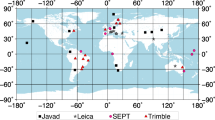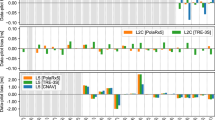Abstract
GLONASS clock offset estimation is affected by the inter-channel biases (ICBs) caused by frequency division multiple access technique. The effect of ICBs on joint GPS/GLONASS clock offset estimation is analyzed. An efficient approach for joint estimation of GPS/GLONASS satellite clock offset is applied to the generation of 30-s clock offset products. During the estimation, the following three ICB handling strategies were tested: calculating ICBs for each GLONASS signal channel, calculating ICBs for each GLONASS satellite and neglecting ICBs. The behavior of ICBs under different strategies was statistically stable. Subsequently, the clock offset products using different ICB strategies were evaluated. The evaluation shows that consideration of the ICB is important when estimating the clock offset. Furthermore, estimating one ICB for each GLONASS satellite is better than estimating one for each GLONASS signal channel because, with the former strategy, the clock offset products behave more smoothly and have higher accuracy compared with products from the International GNSS Service Analysis Center. In addition, precise point positioning, using clock offsets based on one ICB for each GLONASS satellite, has the highest positioning accuracy.







Similar content being viewed by others
References
Bock H, Dach R, Jäggi A, Beutler G (2009) High-rate GPS clock corrections from CODE: support of 1 Hz applications. J Geod 83(11):1083–1094
Cai C, Gao Y (2007) Precise point positioning using combined GPS and GLONASS observations. J Glob Position Syst 6(1):13–22
Cai C, Gao Y (2013) Modeling and assessment of combined GPS/GLONASS precise point positioning. GPS Solut 17(2):223–236
Cai C, Kuang C, Dai W (2012) Performance analysis of combined GPS/GLONASS precise point positioning. Sci Surv Mapp 37(3):183–185
Dach R, Schaer S, Hugentobler U, Schildknecht T, Gäde A (2006) Combined multi-system GNSS analysis for time and frequency transfer. In: Frequency and time forum (EFTF), 20th European. IEEE, pp 530–537
Dach R, Lutz S, Walser P, Fridez P (2015) Bernese GNSS Software Version 52. University of Bern, Bern Open Publishing, Bern. doi:10.7892/boris.72297
Dow JM, Neilan R, Rizos C (2009) The international GNSS service in a changing landscape of global navigation satellite systems. J Geod 83(3–4):191–198
Drinkwater MR, Haagmans R, Muzi D, Popescu A, Floberghagen R, Kern M, Fehringer M (2007) The GOCE gravity mission: ESA’s first core explorer. In: Proceedings of the 3rd international GOCE user workshop, Frascati, Italy, November 6–8. ESA Special Publication, pp 1–8
Ge M, Chen J, Douša J, Gendt G, Wickert J (2012) A computationally efficient approach for estimating high-rate satellite clock corrections in realtime. GPS Solut 16(1):9–17
Han S-C, Kwon J, Jekeli C (2001) Accurate absolute GPS positioning through satellite clock error estimation. J Geod 75(1):33–43
Jäggi A, Hugentobler U, Bock H, Beutler G (2007) Precise orbit determination for GRACE using undifferenced or doubly differenced GPS data. Adv Space Res 39(10):1612–1619
Kouba J (2009) A guide to using International GNSS Service (IGS) products Geodetic Survey Division, Natural Resources Canada. ftp://igs.org/pub/resource/pubs/UsingIGSProductsVer21.pdf
Kouba J, Springer T (2001) New IGS station and satellite clock combination. GPS Solut 4(4):31–36
Li X, Zhang X, Ge M (2011) Regional reference network augmented precise point positioning for instantaneous ambiguity resolution. J Geod 85(3):151–158
Montenbruck O, Hauschild A (2013) Code biases in multi-GNSS point positioning. In: Proceedings of the ION ITM-2013. Institute of Navigation, San Diego, CA, January 28–30, pp 616–628
Montenbruck O, Gill E, Kroes R (2005) Rapid orbit determination of LEO satellites using IGS clock and ephemeris products. GPS Solut 9(3):226–235
Odijk D, Teunissen PJ, Zhang B (2012) Single-frequency integer ambiguity resolution enabled GPS precise point positioning. J Surv Eng 138(4):193–202
Reigber C, Lühr H, Schwintzer P (2002) CHAMP mission status. Adv Space Res 30(2):129–134
Schaer S (1999) Mapping and predicting the Earth’s ionosphere using the global positioning system. Doctoral dissertation, University of Bern, Switzerland
Shi C, Yi W, Song W, Lou Y, Zhang R (2013) GLONASS pseudorange inter-channel biases and their effects on combined GPS/GLONASS precise point positioning. GPS Solut 17(4):439–451
Song W, Yi W, Lou Y, Shi C, Yao Y, Liu Y, Mao Y, Xiang Y (2014) Impact of GLONASS pseudorange inter-channel biases on satellite clock corrections. GPS Solut 18(3):323–333
Zhang W, Lou Y, Gu S, Shi C, Haase JS, Liu J (2015) Joint estimation of GPS/BDS real-time clocks and initial results. GPS Solut 20(4):665–676
Zumberge J, Gendt G (2001) The demise of selective availability and implications for the international GPS service. Phys Chem Earth Part A Solid Earth Geod 26(6):637–644
Zumberge J, Heflin M, Jefferson D, Watkins M, Webb FH (1997a) Precise point positioning for the efficient and robust analysis of GPS data from large networks. J Geophys Res Solid Earth 102(B3):5005–5017
Zumberge J, Watkins M, Webb F (1997b) Characteristics and applications of precise GPS clock solutions every 30 seconds. Navigation 44(4):449–456
Acknowledgements
This work was partially supported by the Collaborative Precision Positioning Project funded by the Ministry of Science and Technology of the People’s Republic of China, the China Natural Science Funds (NSFC) (Nos. 41231014, 41574033 and 41621091), the National “973 Program” of China (No. 2012CB825604), and the NSFC (No. 41404017). The authors would like to extend their sincere gratitude to iGMAS for providing observation data. We also acknowledge the funding support provided by the State Key Laboratory of Geodesy and Earth’s Dynamics (Institute of Geodesy and Geophysics, CAS) (No. SKLGED2014-3-1-E).
Author information
Authors and Affiliations
Corresponding authors
Rights and permissions
About this article
Cite this article
Chen, Y., Yuan, Y., Ding, W. et al. GLONASS pseudorange inter-channel biases considerations when jointly estimating GPS and GLONASS clock offset. GPS Solut 21, 1525–1533 (2017). https://doi.org/10.1007/s10291-017-0630-9
Received:
Accepted:
Published:
Issue Date:
DOI: https://doi.org/10.1007/s10291-017-0630-9




